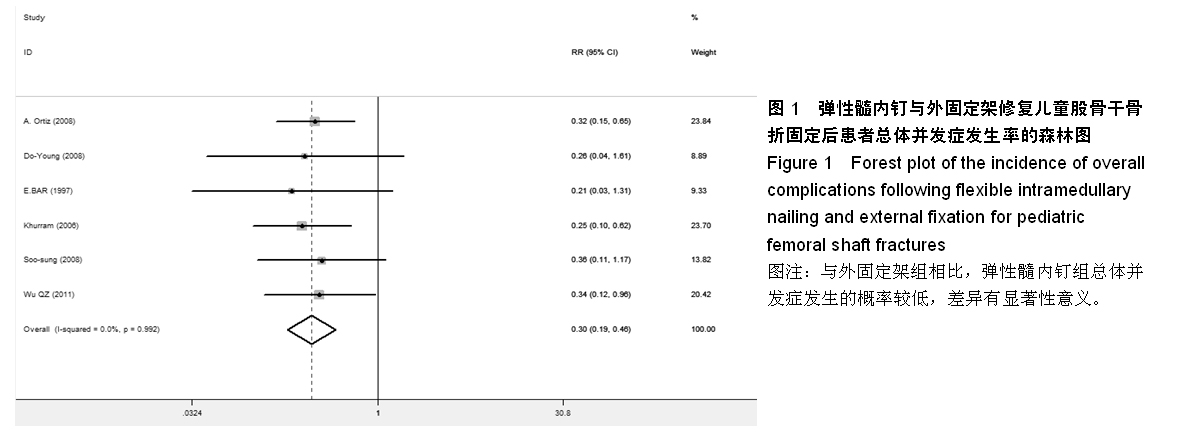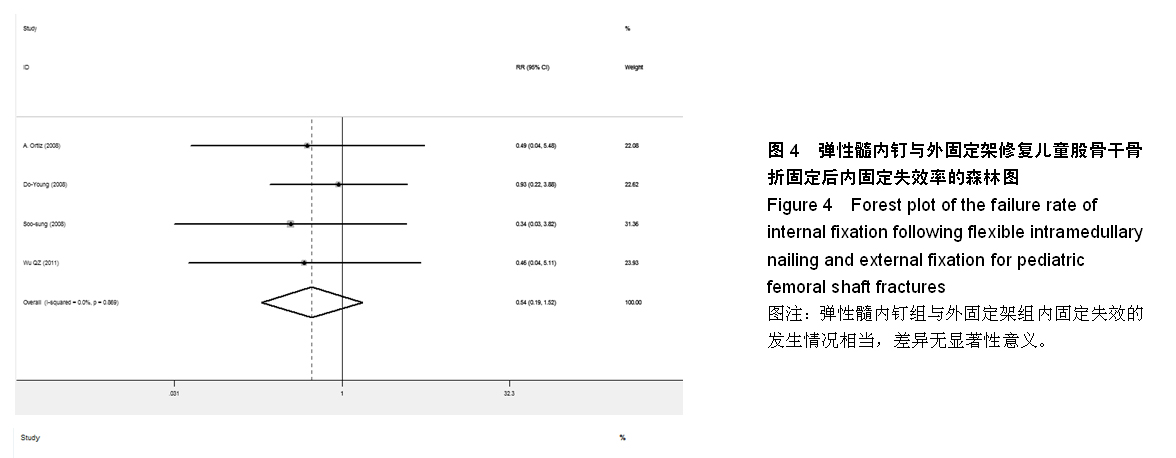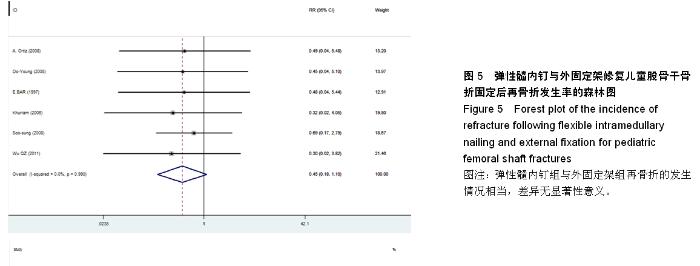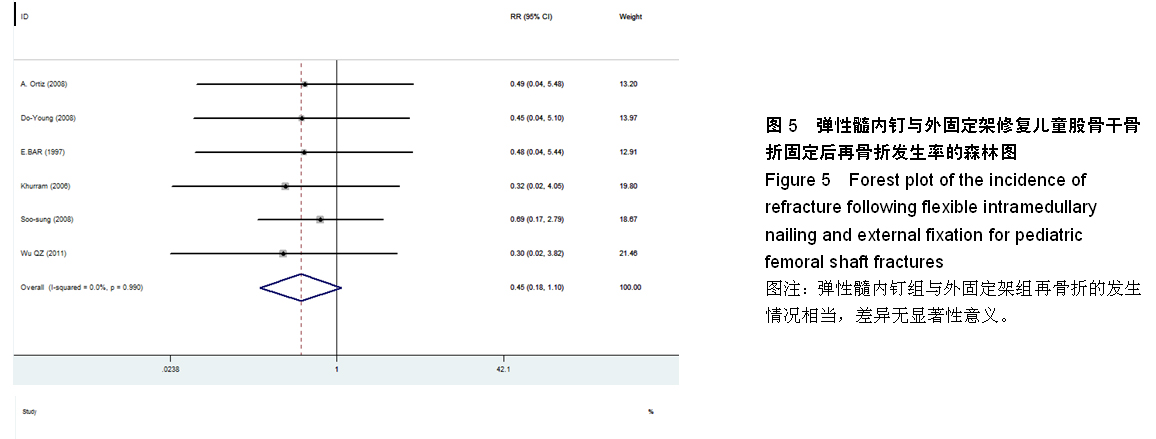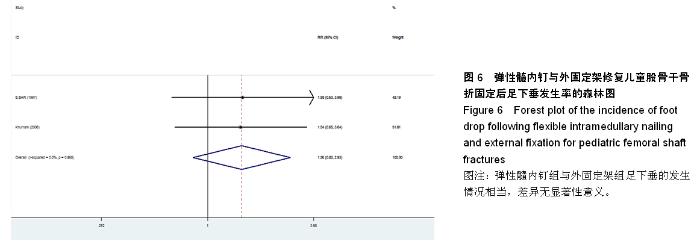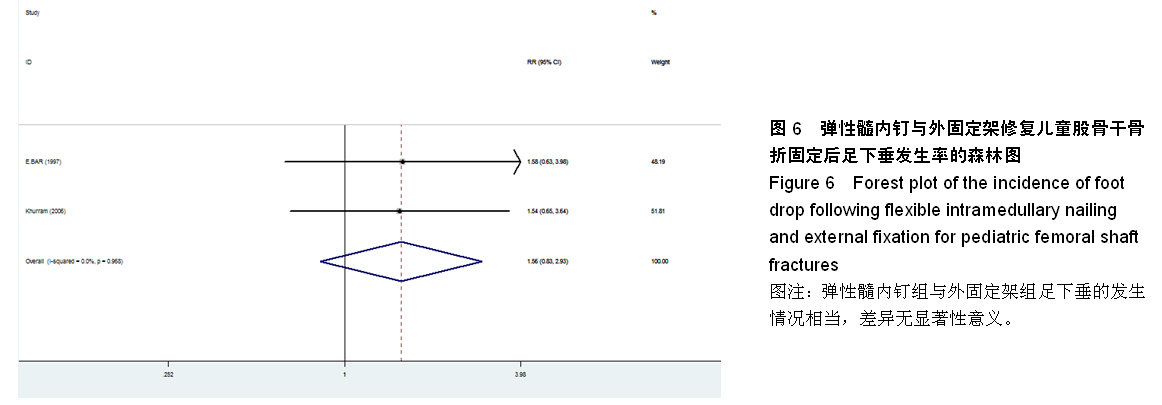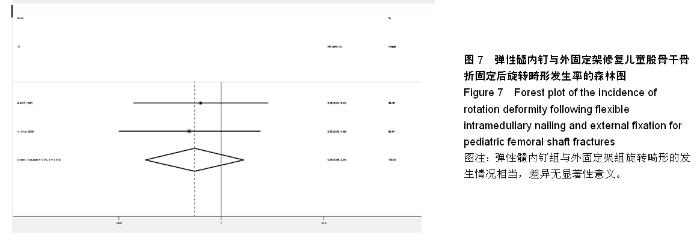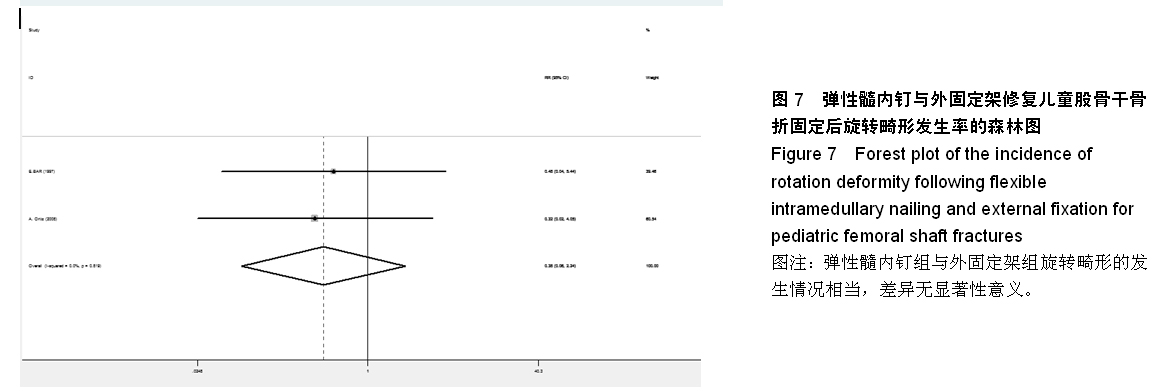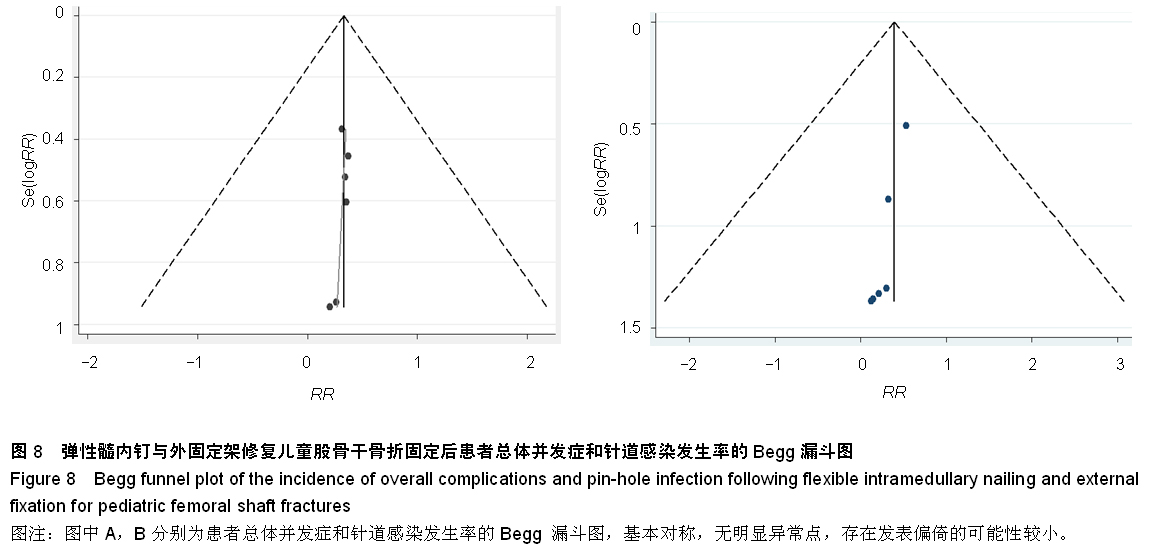Chinese Journal of Tissue Engineering Research ›› 2015, Vol. 19 ›› Issue (31): 5072-5078.doi: 10.3969/j.issn.2095-4344.2015.31.028
Previous Articles Next Articles
Meta-analysis of flexible intramedullary nailing and external fixation for pediatric femoral shaft fractures
Guo Yong-cheng1, Xing Guang-wei1, Xia Bing1, Feng Guo-ming1, Dong Yan-zhao1, Niu Xue-qiang1, He Qian-yi2
- 1Department of Orthopedics, the Third Affiliated Hospital of Zhengzhou University, Zhengzhou 450052, Henan Province, China; 2Department of Neurology, the First Affiliated Hospital of Zhengzhou University, Zhengzhou 450052, Henan Province, China
-
Received:2015-05-12Online:2015-07-23Published:2015-07-23 -
Contact:Xia Bing, Attending physician, Department of Orthopedics, the Third Affiliated Hospital of Zhengzhou University, Zhengzhou 450052, Henan Province, China -
About author:Guo Yong-cheng, Master, Chief physician, Professor, Master’s supervisor, Department of Orthopedics, the Third Affiliated Hospital of Zhengzhou University, Zhengzhou 450052, Henan Province, China -
Supported by:the Zhengzhou Science and Technology Project, No. 131PPTGG409-25
CLC Number:
Cite this article
Guo Yong-cheng, Xing Guang-wei, Xia Bing, Feng Guo-ming, Dong Yan-zhao, Niu Xue-qiang, He Qian-yi. Meta-analysis of flexible intramedullary nailing and external fixation for pediatric femoral shaft fractures[J]. Chinese Journal of Tissue Engineering Research, 2015, 19(31): 5072-5078.
share this article
| [1] 吴素英.髓内钉置入治疗儿童股骨干骨折:来源于SCI数据库的文献分析[J].中国组织工程研究,2012,16(30):5670-5675.
[2] Huber H,André G,Rumeau F,et al.Flexible intramedullary nailing for distal femoral fractures in patients with myopathies.J Child Orthop. 2012;6(2):119-123.
[3] Wani MM,Dar RA,Latoo IA,et al.External fixation of pediatric femoral shaft fractures: a consecutive study based on 45 fractures.J Pediatr Orthop B. 2013;22(6): 563-570.
[4] Nascimento FP, Santili C, Akkari M, et al. Short hospitalization period with elastic stable intramedullary nails in the treatment of femoral shaft fractures in school children. J Child Orthop. 2010;4:53-60.
[5] Jadad RA, Moore RA, Carroll D, et al. Assessing the quality of reports of randomized clinical trials: is blinding necessary? Control Clin Trails. 1996;17:1-12.
[6] Ortiz-Espada A. Elastic nailing vs. external fixation as methods to address pediatric femoral fractures: a review of 40 cases.J Trauma. 2009;53(2):106-112.
[7] Kim DY, Shin SR, Jeong US, et al. Comparison of Flexible Intramedullary Nailing with External Fixation in Pediatric Femoral Shaft Fractures. J Korean Orthop Soc. 2008; 43(1): 30-35.
[8] Baron E, Sagiv S, Porat S. External fixation or flexible intramedullary nailing for femoral shaft fractures in children. J Bone Joint Surg Br. 1997;79-B(6):975-978.
[9] Barlas K, Beg H. Flexible intramedullary nailing versus external fixation of paediatric femoral fractures.Acta Orthop Belg. 2006;72(2):159-163.
[10] Park SS, Park JB. Comparison of Flexible Intramedullary Nailing with External Fixation for Treating Pediatric Femoral Shaft Fractures.J Korean Orthop Soc.2008; 43(6): 665-671.
[11] Wu QZ,Zhang J,Lan SH.Clinical outcomes of elastic intramedullary nail fixation and external fixation for the treatment of pediatric femoral shaft fractures.Zhongguo Gu Shang. 2011;24(2):146-148.
[12] 刘晓强,陈宗雄,王万宗,等.成人肱骨干重建钢板置入治疗儿童股骨干骨折32例:随访分析[J].中国组织工程研究与临床康复, 2010,14(17):3193-3196.
[13] Leu D, Sargent MC, Ain MC, et al. Spica casting for pediatric femoral fractures: a prospective, randomized controlled study of single-leg versus double-leg spica casts. J Bone Joint Surg Am. 2012;94:1259-1264.
[14] Rush JK, Kelly DM, Sawyer JR, et al. Treatment of pediatric femur fractures with the Pavlik harness: Multiyear clinical and radiographic outcomes. J Pediatr Orthop. 2013;33: 614-617.
[15] Heyworth BE, Suppan CA, Kramer DE, et al. Management of pediatric diaphyseal femur fractures. Curr Rev Musculoskelet Med. 2012.[Epub ahead of print].
[16] 王军强,王满宜.骨折的生物学固定[J].中华外科杂志,2002, 40(7): 543-546.
[17] Saseendar S, Menon J, Patro DK. Treatment of femoral fractures in children: is titanium elastic nailing an improvement over hip spica casting? J Child Orthop. 2010;4(3):245-251.
[18] 王华明,陈志龙,李卫平等.弹性髓内钉治疗儿童股骨干骨折钢板固定失效病例[J].中国组织工程研究,2013,17(26): 4819- 4825.
[19] Palmer RH. Biological osteosynthesis. Vet Clin North Am Small Anim Pract. 1999;29:1171-1185.
[20] Aslani H, Tabrizi A, Sadighi A, et al. Treatment of open pediatric tibial fractures by external fixation versus flexible intramedullary nailing: a comparative study. Arch Trauma Res. 2013;2(3):108-112.
[21] 杨明兴,池永龙,王春,等.弹性髓内钉治疗稳定和不稳定性儿童股骨干骨折的病例对照研究[J].中国骨伤,2012,25(2):116-119.
[22] 周永顶,索鹏,王浩杰,等.弹性髓骨钉治疗儿童股骨干骨折的疗效[J].广东医学,2012,33(18):2869-2869.
[23] Krettek C. Forword: concepts of minimally invasive plate osteosynthesis. Injury. 1997;28(Suppl ): A1-2.
[24] Narayanan UG, Phillips JH. Flexibility in fixation: an update on femur fractures in children. J Pediatr Orthop. 2012;32(suppl 1):S32-S39.
[25] 陈日勇,刘运纪.弹性髓内钉固定治疗儿童股骨干骨折[J].实用骨科杂志,2012,18(3):264-265.
[26] 蒋学军,李勇.皮牵引与钛合金弹性钉治疗儿童股骨干骨折的疗效比较[J].山东医药,2014,54(4):101-102.
[27] 钟俊,杨淮河,张军,等.弹性髓内钉微创治疗儿童股骨干骨折的疗效[J].南昌大学学报(医学版),2013,53(10):78-79,82.
[28] Nascimento FP, Santili C, Akkari M,et al. Flexible intramedullary nails with traction versus plaster cast for treating femoral shaft fractures in children: comparative retrospective study.Sao Paulo Med J. 2013;131(1):5-12.
[29] Volpon JB,Perina MM,Okubo R,et al. Biomechanical performance of flexible intramedullary nails with end caps tested in distal segmental defects of pediatric femur models.J Pediatr Orthop.2012;32(5):461-466.
[30] Nascimento FP, Santili C, Akkari M, et al. Short hospitalization period with elastic stable intramedullary nails in the treatment of femoral shaft fractures in school children. J Child Orthop. 2010;4(1):53-60.
[31] Nisar A, Bhosale A, Madan SS, et al. Complications of Elastic Stable Intramedullary Nailing for treating paediatric long bone fractures. J Orthop. 2013;10(1):17-24.
[32] Lascombes P, Nespola A, Poircuitte JM, et al.Early complications with flexible intramedullary nailing in childhood fracture: 100 cases managed with precurved tip and shaft nails. Orthop Traumatol Surg Res. 2012;98:369-375.
[33] 付胜华,覃文报,余永壮,等.弹性髓内钉内固定和外固定支架治疗儿童股骨干骨折的比较[J].中国现代医生,2012,50(23): 148-149.
[34] 孙辽军,杨杰,余贤斌,等.小切口复位与闭合复位弹性钉治疗儿童股骨干骨折的比较研究[J].中华小儿外科杂志,2013,34(9): 673-677.
[35] 杨宏锟,张仲子,赵烽,等.外固定架治疗儿童股骨干骨折疗效分析[J].医药前沿,2013,35(26):225-226.
[36] 崔建,张寰.单臂外固定架在治疗儿童股骨干骨折的临床应用观察[J].徐州医学院学报,2014,34(11):760-761.
[37] Wani MM, Dar RA, Latoo IA, et al.External fixation of pediatric femoral shaft fractures: a consecutive study based on 45 fractures.J Pediatr Orthop B. 2013;22(6):563-570.
[38] Aronson J, Tursky EA. External fixation of femur fracture in children. J Pediatr Orthop. 1992;12:157-163.
[39] Kong H, Sabharwal S. External fixation for closed pediatric femoral shaft fractures: where are we now?Clin Orthop Relat Res. 2014;472(12):3814-3822.
[40] EI Hayek T,Daher AA,Meouchy W, et al. External fixators in the treatment of fractures in children.J Pediatr Orthop B. 2004; 13:103-109.
|
| [1] | Hu Kai, Qiao Xiaohong, Zhang Yonghong, Wang Dong, Qin Sihe. Treatment of displaced intra-articular calcaneal fractures with cannulated screws and plates: a meta-analysis of 15 randomized controlled trials [J]. Chinese Journal of Tissue Engineering Research, 2021, 25(9): 1465-1470. |
| [2] | Huang Dengcheng, Wang Zhike, Cao Xuewei. Comparison of the short-term efficacy of extracorporeal shock wave therapy for middle-aged and elderly knee osteoarthritis: a meta-analysis [J]. Chinese Journal of Tissue Engineering Research, 2021, 25(9): 1471-1476. |
| [3] | Chen Xinmin, Li Wenbiao, Xiong Kaikai, Xiong Xiaoyan, Zheng Liqin, Li Musheng, Zheng Yongze, Lin Ziling. Type A3.3 femoral intertrochanteric fracture with augmented proximal femoral nail anti-rotation in the elderly: finite element analysis of the optimal amount of bone cement [J]. Chinese Journal of Tissue Engineering Research, 2021, 25(9): 1404-1409. |
| [4] | Du Xiupeng, Yang Zhaohui. Effect of degree of initial deformity of impacted femoral neck fractures under 65 years of age on femoral neck shortening [J]. Chinese Journal of Tissue Engineering Research, 2021, 25(9): 1410-1416. |
| [5] | Chen Junming, Yue Chen, He Peilin, Zhang Juntao, Sun Moyuan, Liu Youwen. Hip arthroplasty versus proximal femoral nail antirotation for intertrochanteric fractures in older adults: a meta-analysis [J]. Chinese Journal of Tissue Engineering Research, 2021, 25(9): 1452-1457. |
| [6] | Chen Jinping, Li Kui, Chen Qian, Guo Haoran, Zhang Yingbo, Wei Peng. Meta-analysis of the efficacy and safety of tranexamic acid in open spinal surgery [J]. Chinese Journal of Tissue Engineering Research, 2021, 25(9): 1458-1464. |
| [7] | Wang Yongsheng, Wu Yang, Li Yanchun. Effect of acute high-intensity exercise on appetite hormones in adults: a meta-analysis [J]. Chinese Journal of Tissue Engineering Research, 2021, 25(8): 1305-1312. |
| [8] | Kong Desheng, He Jingjing, Feng Baofeng, Guo Ruiyun, Asiamah Ernest Amponsah, Lü Fei, Zhang Shuhan, Zhang Xiaolin, Ma Jun, Cui Huixian. Efficacy of mesenchymal stem cells in the spinal cord injury of large animal models: a meta-analysis [J]. Chinese Journal of Tissue Engineering Research, 2021, 25(7): 1142-1148. |
| [9] | Huang Dengcheng, Wang Zhike, Cao Xuewei. Intravenous, topical tranexamic acid alone or their combination in total knee arthroplasty: a meta-analysis of randomized controlled trials [J]. Chinese Journal of Tissue Engineering Research, 2021, 25(6): 948-956. |
| [10] | Li Yan, Wang Pei, Deng Donghuan, Yan Wei, Li Lei, Jiang Hongjiang. Electroacupuncture for pain control after total knee arthroplasty: a meta-analysis [J]. Chinese Journal of Tissue Engineering Research, 2021, 25(6): 957-963. |
| [11] | He Xiangzhong, Chen Haiyun, Liu Jun, Lü Yang, Pan Jianke, Yang Wenbin, He Jingwen, Huang Junhan. Platelet-rich plasma combined with microfracture versus microfracture in the treatment of knee cartilage lesions: a meta-analysis [J]. Chinese Journal of Tissue Engineering Research, 2021, 25(6): 964-969. |
| [12] | Hua Haotian, Zhao Wenyu, Zhang Lei, Bai Wenbo, Wang Xinwei. Meta-analysis of clinical efficacy and safety of antibiotic artificial bone in the treatment of chronic osteomyelitis [J]. Chinese Journal of Tissue Engineering Research, 2021, 25(6): 970-976. |
| [13] | Zhan Fangbiao, Cheng Jun, Zou Xinsen, Long Jie, Xie Lizhong, Deng Qianrong. Intraoperative intravenous application of tranexamic acid reduces perioperative bleeding in multilevel posterior spinal surgery: a meta-analysis [J]. Chinese Journal of Tissue Engineering Research, 2021, 25(6): 977-984. |
| [14] | Cai Qunbin, Zou Xia, Hu Jiantao, Chen Xinmin, Zheng Liqin, Huang Peizhen, Lin Ziling, Jiang Ziwei. Relationship between tip-apex distance and stability of intertrochanteric femoral fractures with proximal femoral anti-rotation nail: a finite element analysis [J]. Chinese Journal of Tissue Engineering Research, 2021, 25(6): 831-836. |
| [15] | Liu Jiangfeng. Nano-hydroxyapatite/polyamide 66 composite filling combined with locking plate in the treatment of fibrous dysplasia of femoral bone [J]. Chinese Journal of Tissue Engineering Research, 2021, 25(4): 542-547. |
| Viewed | ||||||
|
Full text |
|
|||||
|
Abstract |
|
|||||



